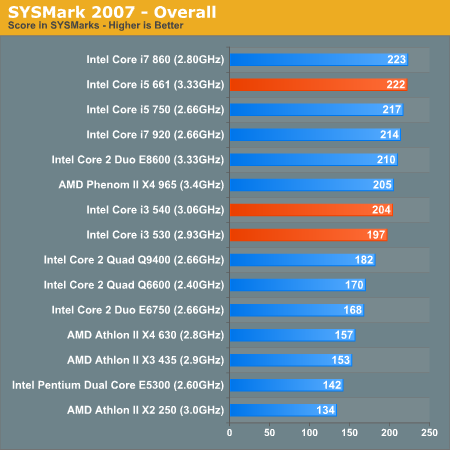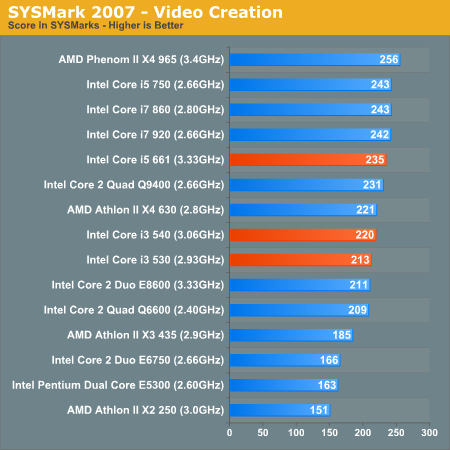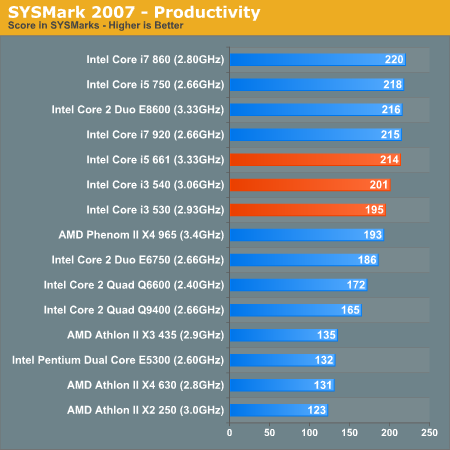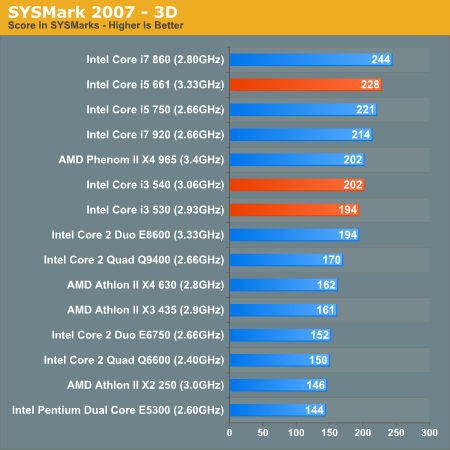The Clarkdale Review: Intel's Core i5 661, i3 540 & i3 530
by Anand Lal Shimpi on January 4, 2010 12:00 AM EST- Posted in
- CPUs
SYSMark 2007 Performance
Our journey starts with SYSMark 2007, the only all-encompassing performance suite in our review today. The idea here is simple: one benchmark to indicate the overall performance of your machine.

SYSMark performance is a strong point of the new Clarkdale family. The Core i5 661 is able to deliver overall performance roughly equivalent to the Core i7 860. If you aren't running heavily threaded code that can really stress all four cores of a Lynnfield or Phenom II, the Core i5 661 is going to perform very similarly.
The real winners however are the simulated Core i3 540 and 530. You give up Turbo Boost but you still maintain Hyper Threading, which delivers Phenom II X4 965 performance for $133. Obviously AMD will still win in most tasks that stress all four cores, but for the majority of users you'll actually have roughly the same performance out of an i3 530. Impressive.
These Clarkdale chips are also a significant performance improvement over the older Core 2 based products. The i3 530 looks to be around 17% faster than the Conroe based Core 2 Duo E6750. Even AMD's value quad-core chips can't compete here, but that's just because we're not really stressing all four threads.














93 Comments
View All Comments
marc1000 - Monday, January 4, 2010 - link
Indeed, I want an Atom+ION, but it has not yet come to public availability in Brazil. And Intel is killing ION with the new Atoms, so I believe I won't ever see a Atom+ION board here, because the stores will only launch only the "newer" Atom boards (that is, IF they even launch it...)efficientD - Saturday, January 9, 2010 - link
The other problem with and atom setup is the low cost no L3 cache Athalons. With a decent 785G mainboard, you can get much better performance in only a slightly bigger package for about the same HTPC money. That is the direction I would go if I could build an HTPC right now.IntelUser2000 - Monday, January 4, 2010 - link
The reason for high idle and in some way, high load power is due to the Asus board. Not only that, but the H57 chipset.The Intel H55 mobo will lower power consumption enough to get it below the i5 750 and i7 860.
Kaleid - Monday, January 4, 2010 - link
Would these be chips on would dare to overclock considering the foxconn socket problems that has been reported here @ anandtech?Zool - Monday, January 4, 2010 - link
Its quite confusing now, with 9 desktop and 11 mobile i-xxx cores now. Not a single digit shows core numbers or the gpu on the new 32nm cpus.Actualy its a total mess now for a average user.
marc1000 - Monday, January 4, 2010 - link
I second your opinion!!! Perhaps Intel hired some marketing folks from Nvidia!!! =DHarry Lloyd - Monday, January 4, 2010 - link
So which chip is responsible for HDMI Audio - the CPU, or the H5x chipset?Can we get HDMI audio support with a Lynnfield CPU?
And one other thing - I assume we can use HDMI audio without haeving to use the integrated GPU (for display) when we have a PCI-E card?
DigitalFreak - Monday, January 4, 2010 - link
The GPU on the processor.Alberto - Monday, January 4, 2010 - link
The main problem is the Motherboard, likely an early sample not much optimized. Both Xbit Lab and The Tech Report have found a lower idle system power consumption in the new Intel plataform versus the Lynnfield solution. Maybe This article needs of a fast update :-)Alberto - Monday, January 4, 2010 - link
The italian site www.hwupgrade.it have discovered even better results. Over an Intel DH55TC motherboard this new cpu is IMPRESSIVE at idle.Intel seems right again.